
"WE’RE in a house of many tight, messy rooms. In the suburbs? Cyberspace? Hard to say. Anyway, it’s night. A door bangs open. A girl, who is also a boy, dashes in, talking, talking. Other people are already there, in gaudy attire, dire wigs and makeup like paint on de Koonings.
Everyone moves in a jerky, speeded-up, look-at-me way and speaks superfast to one another, to the camera, into a cellphone. Phrases whiz by about cloning, family, same-sex adoption, the art world, the end of the world, identity, blogging, the future. Suddenly indoors turns into outdoors, night into day, and we’re at a picnic, in dappled sunshine, with a baby. Then this all reverses, and we’re indoors again. A goth band is pounding away in the kitchen. The house is under siege. Hysteria. Everyone runs through the walls.
This is a highly impressionistic account of Ryan Trecartin’s sensationally anarchic video “I-Be Area,” which made its debut in the Elizabeth Dee Gallery in Manhattan last fall. The piece caused a stir, in part because most people had never seen anything quite like it before, certainly not in an art gallery.
Art video still has a funny reputation, left over from the 1960s, of being a serious medium, made for function rather than pleasure, as opposed to film. Yet “I-Be Area” was pleasure all the way. It was nonstop visual razzle-dazzle. It drew on every cheap-thrill trick in the digital graphics playbook.
More radically, it was the length of a feature film. More radically still, it told a story, one with dozens of characters and multiple subplots, which is what entertainment, not art, is supposed to do, if you assume there’s a hard and fast difference between the two.
Mr. Trecartin, apparently, does not assume this. He is not alone. The American artist and performer Kalup Linzy, for example, has invented a serial soap opera around a dysfunctional African-American family. Sadie Benning uses hand-drawn animation to tell bittersweet tales of urban gay life. Nathalie Djurberg, born in Sweden and living in Berlin, sculptures clay figures and sets them in sadistic encounters. These artists, using video that is cheaper and more accessible than ever thanks to digital technology, are creating a new kind of 21st-century art that is narrative in form and potentially epic in scale.
At present it is shaped by a combination of pop fantasy, ingrained cybersmarts, neo-tribalism and an angst-free take on contemporary life that marks an attention-deficient Internet culture.
The relationship of this work to an art world structured on galleries, museums and fairs is, potentially at least, one of detachment. You can experience “I-Be Area” on a laptop wherever and whenever you want. That may be a reason why few of these new video artists feel the need to live in New York City. They have chosen a medium that is not only flexible and affordable but has a history of embracing experimentation.
Video 40 years ago offered restless, penurious, disenfranchised and performance-based artists (many women worked in early video) an alternative to the blue-chip clubbiness of Pop painting and Minimalist sculpture. Video was associated with television and newsreels, not art. It was available and fairly easy to learn. Because it had no aesthetic history, it came with no fixed expectations. Using it allowed artists like Vito Acconci, Joan Jonas, Nam Jun Paik to open a fresh chapter in art history."




 From the MoMA's website
From the MoMA's website
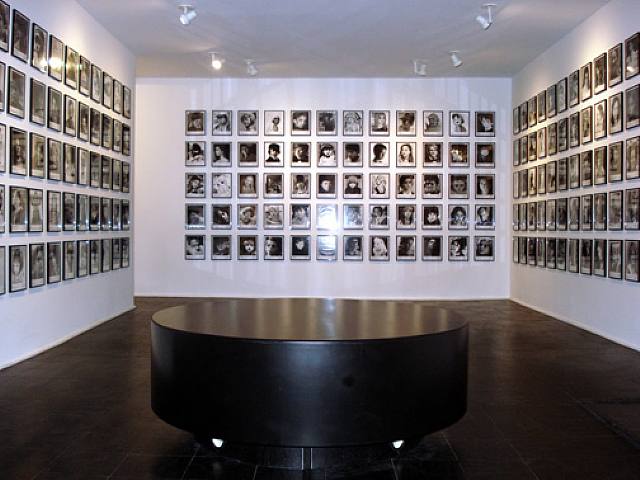

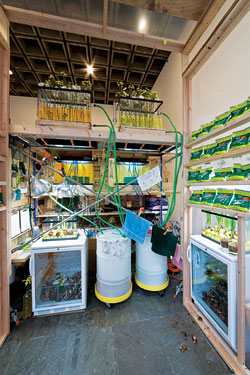 The Whitney Biennial, chockablock with bloodless M.F.A. product, is a little too smart for its own good.
The Whitney Biennial, chockablock with bloodless M.F.A. product, is a little too smart for its own good.
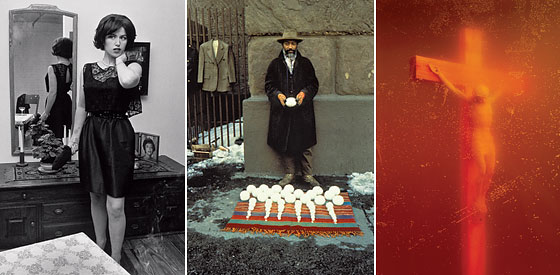 From Jerry Saltz for New York Magazine's 40th Anniversary
From Jerry Saltz for New York Magazine's 40th Anniversary


 Design and the Elastic Mind runs at the MoMA thru May 12, 2008
Design and the Elastic Mind runs at the MoMA thru May 12, 2008



 Bjarne Melgaard at Green Naftali thru March 15.
Bjarne Melgaard at Green Naftali thru March 15.



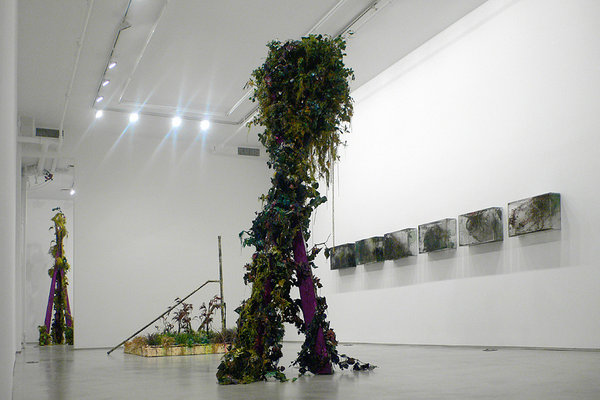





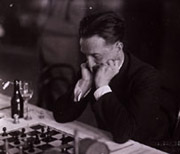 Diana Thater at David Zwirner gallery thru February 9th.
Diana Thater at David Zwirner gallery thru February 9th.
 Shirin Neshat at Barbara Gladstone Gallery thru February 23.
Shirin Neshat at Barbara Gladstone Gallery thru February 23. 








 The New Museum moves to the Bowery
The New Museum moves to the Bowery the 30 years since its founding, has never quite hit its stride; it has usually bounced between being audacious and being annoying. Partly it’s because other New York museums have been so uneven about contemporary art. MoMA is adrift, the Guggenheim’s leaders continue to make terrible decisions, and the Brooklyn Museum is a giant wasted opportunity. The general feeling is, this is the New Museum’s last best chance to get it right."
the 30 years since its founding, has never quite hit its stride; it has usually bounced between being audacious and being annoying. Partly it’s because other New York museums have been so uneven about contemporary art. MoMA is adrift, the Guggenheim’s leaders continue to make terrible decisions, and the Brooklyn Museum is a giant wasted opportunity. The general feeling is, this is the New Museum’s last best chance to get it right."

